A visit with author Dr. Ricken Lazlo Hale, wherein he talks about his life living in a ‘living’ machine-for-living
By Douglas J. Klostermann
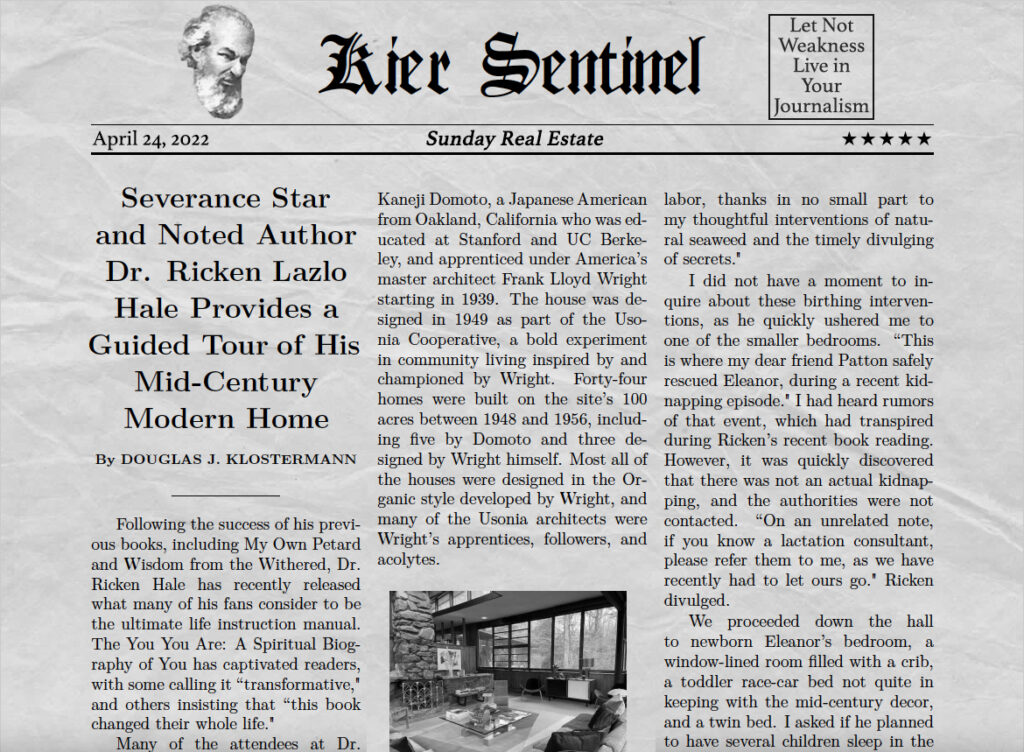
Following the success of his previous books, including My Own Petard and Wisdom from the Withered, Dr. Ricken Hale has recently released what many of his fans consider to be the ultimate life instruction manual. The You You Are: A Spiritual Biography of You has captivated readers, with some calling it “transformative,” and others insisting that “this book changed [their] whole life.”

Many of the attendees at Dr. Hale’s initial reading of this latest book were not only awed by his profound words, illuminating ideas, and wavering voice, but also by his warm and welcoming Mid-Century Modern home, nestled in the woods in the winter landscape of Kier, PE. As an aficionado of Mid-Century architecture and design, I asked to meet up with Dr. Hale to learn more about this special house that he shares with his wife and newborn daughter.
“Welcome, welcome. Please, call me Ricken,” the author proclaimed as he greeted me at the glass-paned front door of his home, and ushered me into the foyer. “The space before you was originally the consultation room of the original owner, a certain Dr. Arthur Bier, who lived here with his wife Gertrude, and their two daughters,” Ricken knowingly informed me.

I had recently learned this information myself, as I had dutifully studied the original plans for the house, hand-drawn by the designer Kaneji Domoto, a Japanese American from Oakland, California who was educated at Stanford and UC Berkeley, and apprenticed under America’s master architect Frank Lloyd Wright starting in 1939. The house was designed in 1949 as part of the Usonia Cooperative, a bold experiment in community living inspired by and championed by Wright. Forty-four homes were built on the site’s 100 acres between 1948 and 1956, including five by Domoto and three designed by Wright himself. Most all of the houses were designed in the Organic style developed by Wright, and many of the Usonia architects were Wright’s apprentices, followers, and acolytes.

“Let the tour commence,” Ricken announced, as he shepherded me past the breakfast room and galley kitchen, and down a winding hall toward the bedroom wing. I asked him how he came about living in this house, and Ricken began to explain, “Once I had broke the world of literature, I desired to live in a house that broke the world of architecture.”
Indeed, Wright’s designs and those directly inspired by him had a tremendous influence on architecture, far beyond the exceptional collection of homes in the Usonia community. Countless architects and designers adopted Wright’s Organic philosophy of using natural materials such as wood and stone, integrating the building into the surrounding landscape, bringing the natural world into the house through abundant windows and intentional vistas, and creating open spaces that flowed into each other.

We rounded a corner and entered the master bedroom, where we encountered Ricken’s wife Devon Scout-Hale, who was in the process of expressing milk for the couple’s newborn daughter. “We have recently given birth to the new love of my life, my daughter Eleanor Ricken Scout-Hale Hale,” the proud father declared. “My wife and I joyfully survived the labor, thanks in no small part to my thoughtful interventions of natural seaweed and the timely divulging of secrets.”
I did not have a moment to inquire about these birthing interventions, as he quickly ushered me to one of the smaller bedrooms. “This is where my dear friend Patton safely rescued Eleanor, during a recent kidnapping episode.” I had heard rumors of that event, which had transpired during Ricken’s recent book reading. However, it was quickly discovered that there was not an actual kidnapping, and the authorities were not contacted. “On an unrelated note, if you know a lactation consultant, please refer them to me, as we have recently had to let ours go.” Ricken divulged.

We proceeded down the hall to newborn Eleanor’s bedroom, a window-lined room filled with a crib, a toddler race-car bed not quite in keeping with the mid-century decor, and a twin bed. I asked if he planned to have several children sleep in the room, but Ricken explained that a child should be able to view and choose their own bed, throughout their life development.
As we returned toward the kitchen, I noted several portraits of Ricken throughout the spaces. He informed me that when he first moved into the house, he required all of his artistic friends and colleagues to provide a drawn, painted, or photographic portrait of him, as a housewarming gift. “I do not wish for the house to forget me in my absence, nor to fear me upon my return.” he explained.
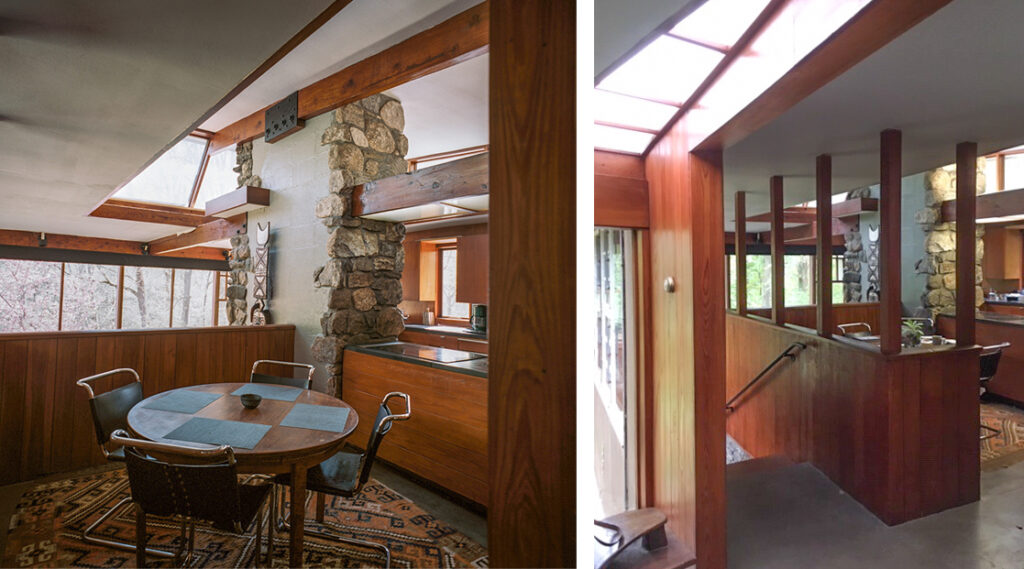
Just before reaching the kitchen, we stepped out through a sliding door onto the deck, or Dining Terrace as the architect officially designated it on the floor plans.“This deck was originally built around a large tree, as you can see by the pattern of a now-covered hole, and the notch designed into the roof’s overhang above. It seems that at some point in the house’s history, the tree was misplaced. Perhaps I shall be the one who relocates it,” Ricken declared. “Or perhaps one of the imbibers from the local tavern down below took it with him one night…?” Ricken pondered.
The heart of this house is of course the living room with its high ceiling, its natural stone fireplace, and towering chimney surrounded with skylights. Dark wood beams stand out overhead against the white plaster ceiling. The living room is located 6 steps down (“Exactly 3 feet, 4 inches lower” Ricken informs me) from the entry / kitchen / bedroom level, and can be viewed from the kitchen and the breakfast room.
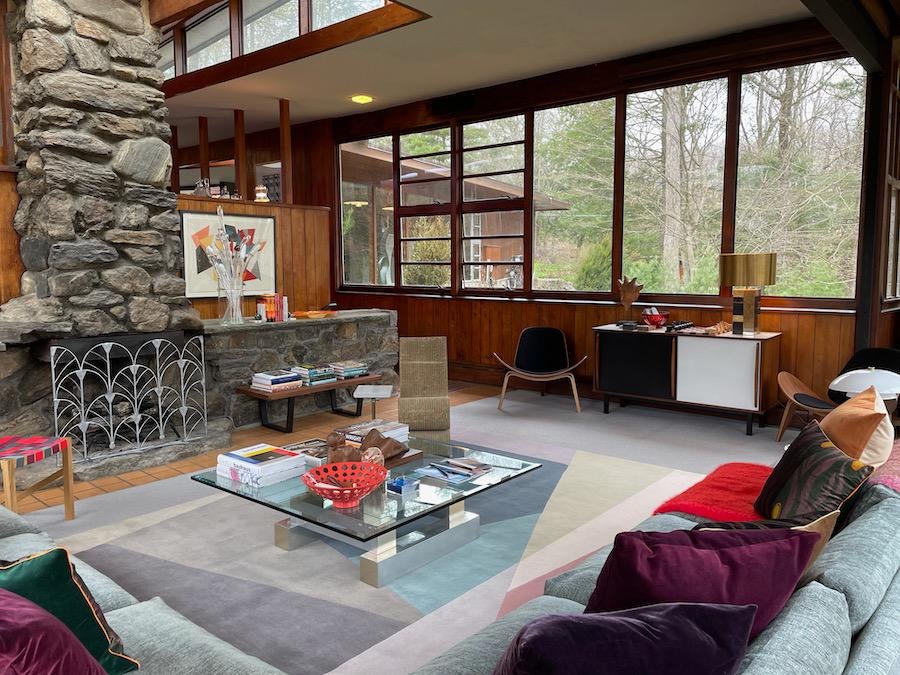
“This is where I host all my book readings, as well as my conversation-less debates, and no-singing Karaoke sing-along nights,” Ricken shared. Light and nature fill the room through the large windows that completely surround the space on the east, south, and west sides. Ricken has tastefully decorated the living room space with mid-century icons including a George Nelson slat bench-table, a leather-covered Hans Wegner Shell Chair, a Charlotte Perriand mahogany black and white sideboard, as well as a more recent Frank Gehry cardboard Wiggle Chair. I noted that a geometric-motif rug very much tied the room together. On the sectional sofa lay a throw pillow embroidered with a quote by Michel Foucault, “I don’t write a book so that it will be the final word; I write a book so that other books are possible, not necessarily written by me.”

Domoto’s original design for the Biers was later modified and enlarged by later owners, the Cooper family. A balcony off the southern side of the living room was enclosed and incorporated into the living room, in order to enlarge that space. The geometric window patterns with opaque panes at the corners of the living room space were added when the balcony was enclosed, and are now a distinctive element of the house. When the living room was enlarged, the open outdoor area that it dramatically cantilevered over was also enclosed, to add more lower-level living-space to the house. The now-larger living room comes in handy during Ricken’s popular book readings. “There were so many attendees, some were forced to share copies of my book as they followed along,” Ricken informed me about the recent reading. “I saw much craning,” he added.
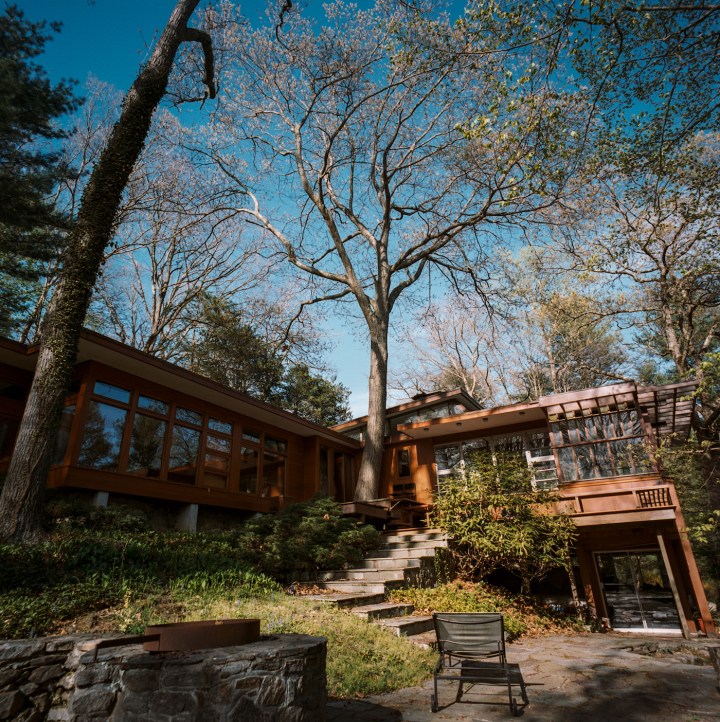
While Kaneji Domoto’s design for the Bier House resembles many of the mid-century houses in the community, and contains several of the elements of Wright’s Organic Usonian houses, Frank Lloyd Wright did not actually like the design, and refused to approve any of Domoto’s plans. Wright called Domoto a “green amateur” who designed “half-baked imitations.” In one letter, Wright stated that “Kan’s designs are lousy — pretentious imitations.” Eventually, after repeatedly rejecting the plans, Wright demanded Domoto’s resignation.

The other Usonia architects protested to Wright that Domoto was brought to the project because of his status as one of Wright’s apprentices at his home and studio, Taliesin. In fact, Domoto had to abandon his education with Wright when he and his family were forcibly detained at a Japanese Internment Camp during World War II. Although Wright himself asked for Domoto’s release from the camp, Wright later denied to the Usonia team that Domoto was a student at Taliesin, and instead claimed that “he was a gardener.”
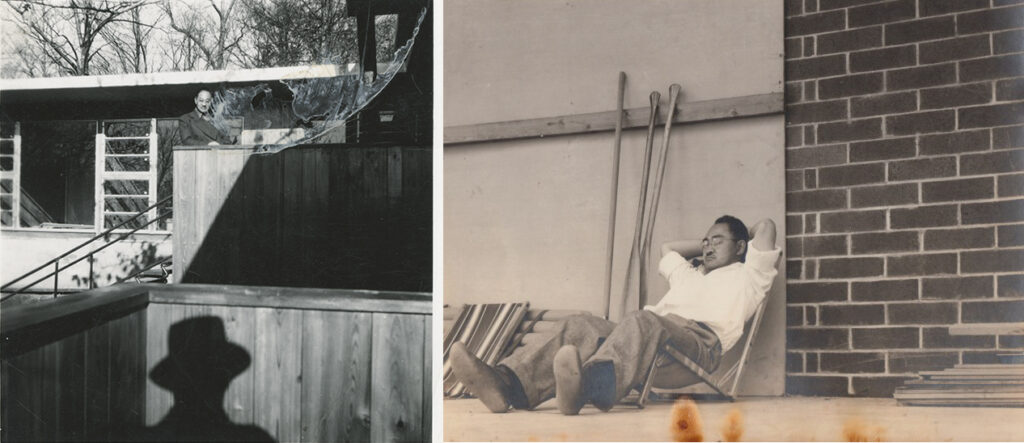
The families at Usonia who had commissioned houses from Domoto fought for the young architect’s continued inclusion in the project, and even began constructing his designs without Wright’s explicit approval. The situation so ruffled Wright that the master architect eventually left the Usonia Cooperative project, explaining that he would finish his own three designs, but offer no more leadership or involvement. Domoto continued and eventually completed five houses on the site, but lost clients to other Usonia architects. The Bier House was the largest of Domoto’s contributions.
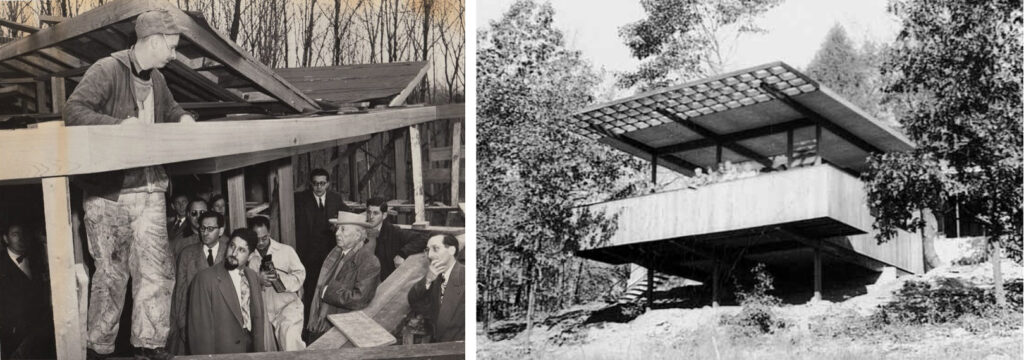
Wright was also disapproving that Domoto’s design contained overtones of the International Style of architecture, a style with sharp, rigid geometries and colder metal, glass, and marble materials. Proponents of that style often proudly called their houses “machines for living.” I asked Ricken about his thoughts of the combination of rigid International Style components along with living Organic architecture elements.
“I have found the combination to be intriguing, and perhaps ideal. Because this house incorporates the two prominent mid-century architectural styles, I am able to live my life in a ‘living’ machine-for-living.” This brought to mind Ricken’s contrast of man and machine that he expounded upon in his latest book, and Ricken readily agreed, saying “Most machines are made from metal, while this one is made from wood and stone and glass and concrete. And also, it has doors and windows and Himalayan throw rugs.”
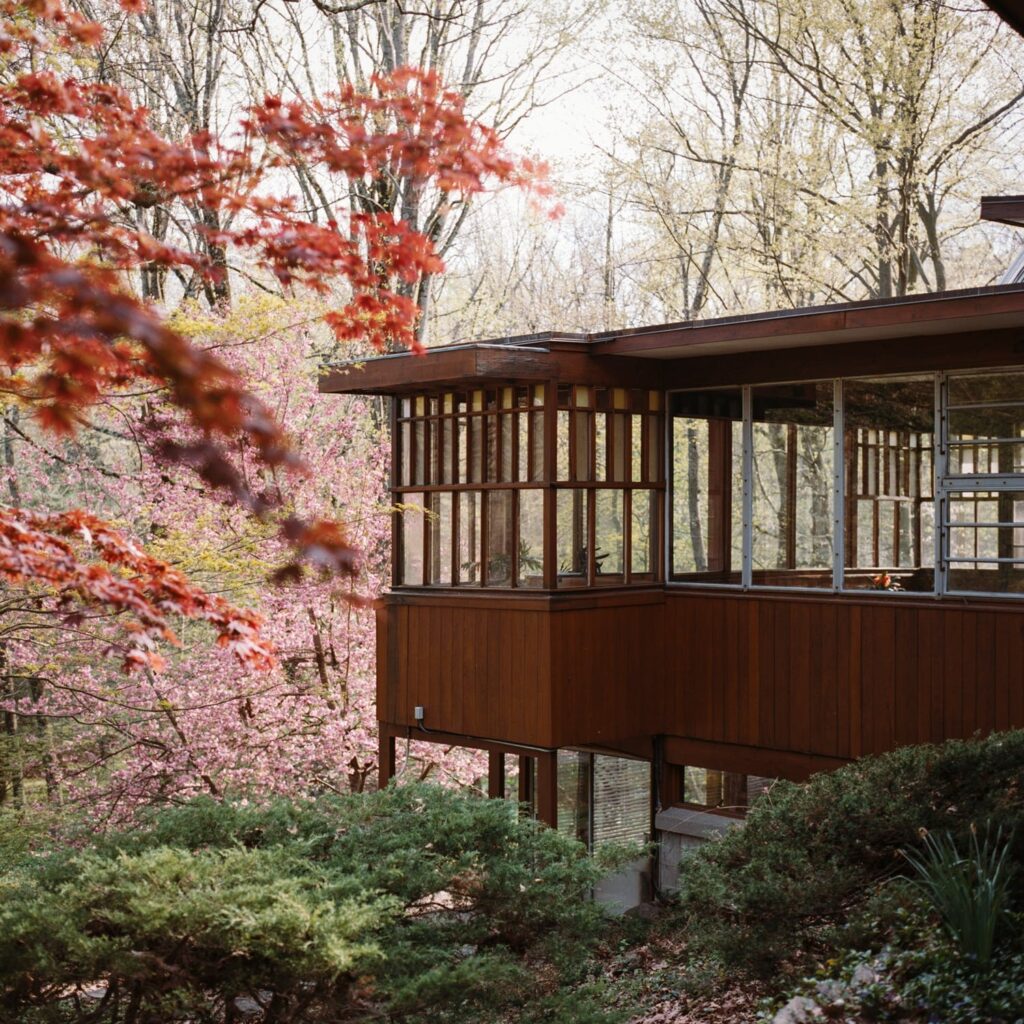
When I inquired about another set of stairs that led down from the living room, Ricken invited me to descend to a small study and guest room plus mechanical space tucked under the kitchen. Originally it was a discrete space, but now serves as a transition to the added lower spaces that were part of the later owners’ renovations. Following a musty, earthy odor, we continued down to the added space below the living room, which is currently filled with large bundles of wool, fabrics, and weavings. “This is where I work my Baltic hand loom,” he explained. “I will now demonstrate.” Deflecting my kind but firm protests, Ricken began to weave, elucidating the intricacies of warps and wefts, and explaining how he is compelled to use wool from Emsket-colored sheep who sleep on the south side of a knoll.
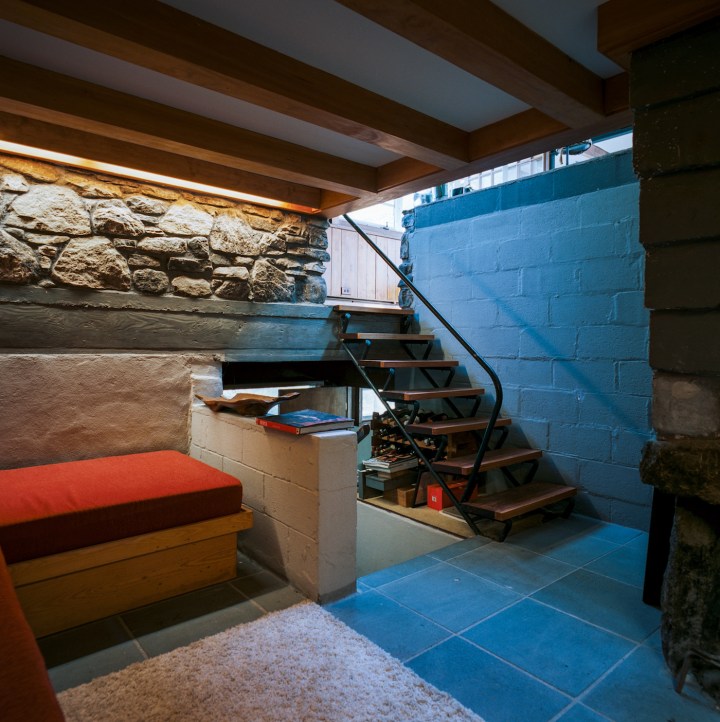
“Once I initiated my weaving projects for dear Eleanor’s linens, I had to disassemble my medieval bookbinding workbench, and temporarily place my small-mammalian taxidermy station into storage.” When I marveled at his numerous hobbies and undertakings, Ricken pointed to one of the room’s electrical outlets and explained, “Just as electrical outlets are needed to release surplus electricity into lamps, personal outlets are needed to release manifold talents into life.”
At the conclusion of the weaving demonstration, we returned upstairs for a respite in the concrete-floored dining room. Accented with a natural stone wall on the eastern side that is fronted with a built-in mahogany buffet and recessed overhead lighting, the space also boasts full-length glass panes that run across the room’s southern wall. The dining room was the house’s original car port, but was enclosed by later owners as part of their renovations.

Ricken offered me a coffee with warm goat milk, served from an enviable mahogany beverage trolley that he recently acquired from the local Midcenturion vintage furniture store. “This week I am sampling Liberica beans from the Philippines,” he purposefully mentioned as we sat for a moment under pendant lighting at the hexagonal table. “I individually hand-ground many of the beans myself, before aggravating my finger tendons and outsourcing the project to my aide Balf.” As with the rest of the house, the concrete floors emit radiant heating, as hot water flows through copper tubes embedded in the poured concrete. This was a heating technique also favored by Frank Lloyd Wright in his Usonian houses.
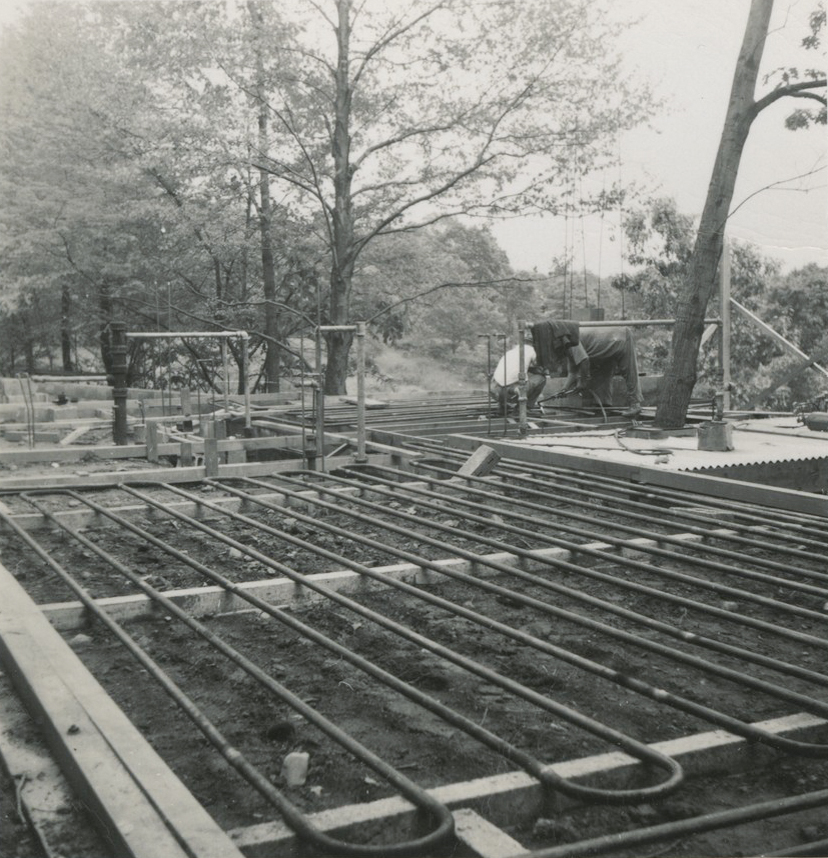
After Ricken demonstrated the proper method of slurping a Liberica, I asked him about the origins of his writing career. He explained that after misguided attempts at being a lamp electrician, a daffodil gardener, and a tree-and-pond photographer, he returned to his first childhood passion of introspective writing. “Just as you must send out your image to a mirror in order for it to return as your reflection, you must send out your thoughts to the world in order for them to return in the guise of self-reflection,” he explained. “But listen to me, prattling on like an airport weatherman about my writing, my house, and myself. Why don’t you tell me what you think of my writing, my house, and myself?”
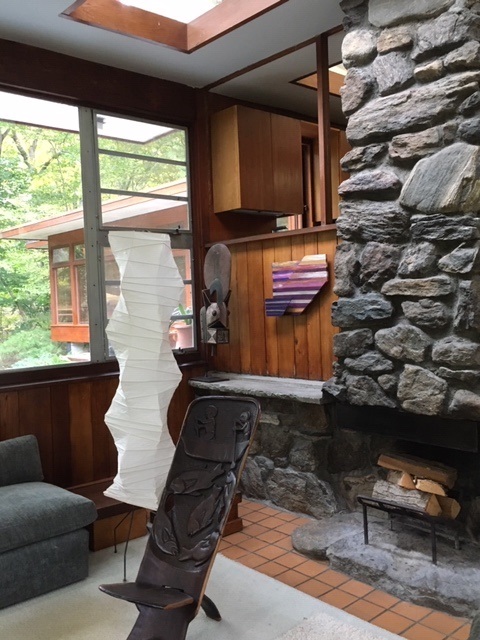
Dr. Ricken Lazlo Hale, PhD is the author of five books, including The You You Are: A Spiritual Biography of You, My Own Petard, Life of an American Gadfly, Wisdom from the Withered, and The Fun in Profundity. His books can be found at many of the finest airport booksellers.
His upcoming book signing event at Selvig’s Flowers in Downtown Kier has, unfortunately, been cancelled.
You can follow his many Twitter pages here https://twitter.com/DrRickenHale here https://twitter.com/TheYouYouAreBot and here https://twitter.com/michaelchernus and also here https://twitter.com/DanErixon
Do you enjoy refining macrodata? Then shop the look!
https://amzn.to/3SUTRXO
If you wish to learn more about architect Kanji Domoto, the Bier House, and the Usonia Cooperative, as well as view additional photographs, plans, and a full PDF book about Usonia, links are provided below.
Ricken did not succeed as a tree-and-pond photographer because he never read any of my comprehensive and user-friendly Nikon, Canon, and Sony camera guides. Don’t make the same mistake – learn to take control of your camera and the images you create, with my Full Stop camera guides: www.fullstopbooks.com
In an ongoing project, Ricken has asked his photographer and filmmaker friends and colleagues to document his everyday life. Many of these recordings have been shared in a nine-part Apple TV+ presentation titled Severance. Some images and video stills that he has kindly shared, to help illustrate this article, can be viewed at this companion link:
http://blog.dojoklo.com/2022/04/28/devon-and-ricken-hale-house-in-kier-pe/
Sources and Resources
Original architectural drawings and construction photographs, Domoto (Kaneji) Collection at UC Berkeley
https://calisphere.org/item/7e55449f-d89c-4e9d-a077-1eec378967de/
http://exhibits.ced.berkeley.edu/exhibits/show/domoto/usonia–an-experiment-in-livin/arthur-and-gertrude-bier-house
Visiting Usonia, by Waverly Lowell
https://archives.ced.berkeley.edu/blog/archives/2019/10
Step into Houses Designed by Frank Lloyd Wright Acolyte Kaneji Domoto, by Zachary Edelson
https://metropolismag.com/projects/kaneji-domoto-usonia-house-exhibition-photography/
The Complicated Story Behind the Only Japanese-American Architect at Frank Lloyd Wright’s Usonia, by Elizabeth Fazzare
https://www.architecturaldigest.com/story/kaneji-domoto-only-japanese-american-architect-at-frank-lloyd-wright-usonia
The Japanese American Architect Who Was a Disciple of Frank Lloyd Wright, by Claire Voon
https://hyperallergic.com/392963/kaneji-domoto-frank-lloyd-wright-usonia/
Exhibition on Life and Career of Renowned Nisei Landscape Architect Kaneji Domoto, by Rafu Reports
https://rafu.com/2019/08/exhibition-on-life-and-career-of-renowned-nisei-landscape-architect-kaneji-domoto/
Usonia Community Remembers its Past, by Scott Riklin (paywall)
https://www.nytimes.com/1981/08/30/nyregion/usonia-community-remembers-its-past.html?sec=&spon=&pagewanted=1
The Wright Stuff, by Jill Clateman
https://westchestermagazine.com/uncategorized/the-wright-stuff/
Usonia, New York – Building a Community with Frank Lloyd Wright, by Roland Reisley (PDF copy of book)
Preview: https://issuu.com/papress/docs/9781568982458
Additional images of Ricken Hale’s interior decor, by SeveredSetDirector
https://www.reddit.com/r/SeveranceAppleTVPlus/comments/tz3696/in_the_outie_world_weve_seen_bits_of_devon/

